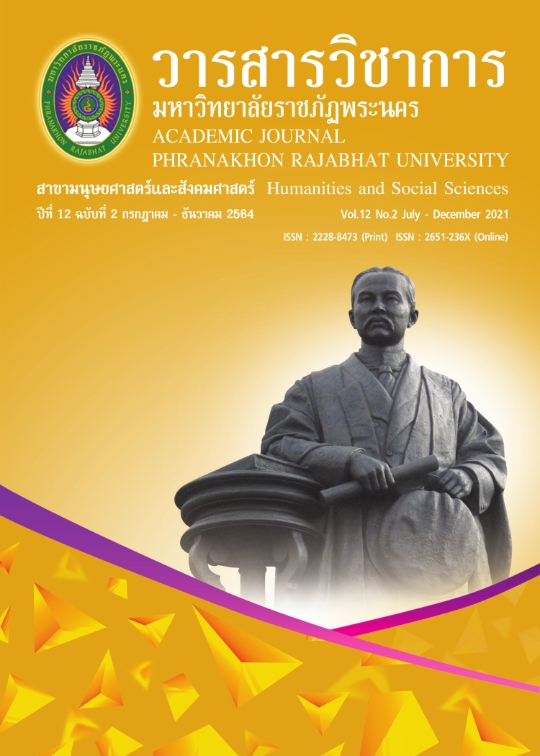กลยุทธ์ของสถาบันอุดมศึกษาของรัฐภาคเหนือตอนบนในการให้โอกาสทางการศึกษาแก่เยาวชนกลุ่มชาติพันธุ์
คำสำคัญ:
สถาบันอุดมศึกษาของรัฐภาคเหนือตอนบน, โอกาสทางการศึกษา, เยาวชนกลุ่มชาติพันธุ์บทคัดย่อ
การวิจัยนี้ มีวัตถุประสงค์เพื่อศึกษานโยบาย ระบบ และกลไกของสถาบันอุดมศึกษาของรัฐภาคเหนือตอนบนในการให้โอกาสทางการศึกษาแก่เยาวชนกลุ่มชาติพันธุ์ เพื่อสังเคราะห์ปัจจัยที่ส่งผลต่อโอกาสทางการศึกษาในเยาวชนกลุ่มชาติพันธุ์ และเพื่อจัดทำกลยุทธ์ส่งเสริมโอกาสในการศึกษาในสถาบันอุดมศึกษาของรัฐแก่เยาวชนกลุ่มชาติพันธุ์ เป็นการวิจัยแบบผสมผสาน ใช้เทคนิคเชิงคุณภาพคือแบบสัมภาษณ์ โดยเก็บข้อมูลจากประชากรผู้ให้ข้อมูลหลักคือผู้บริหารของสถาบันอุดมศึกษากลุ่มมหาวิทยาลัยราชภัฏทั้ง 4 แห่ง จำนวน 4 คน ได้แก่ อธิการบดีและรองอธิการบดีที่ได้รับมอบหมายซึ่งเป็นผู้รับผิดชอบด้านการจัดการศึกษาโดยตรง และเชิงปริมาณคือแบบสอบถามในการเก็บรวบรวมข้อมูลจากกลุ่มตัวอย่าง คือ นักศึกษากลุ่มชาติพันธุ์ของสถาบันอุดมศึกษาแห่งละ 10 คน รวม 40 คน วิเคราะห์ข้อมูลโดยการวิเคราะห์เนื้อหา หาค่าร้อยละและค่าเฉลี่ย ผลการวิจัยพบว่า นโยบาย ระบบและกลไกของสถาบันอุดมศึกษาของรัฐภาคเหนือตอนในการให้โอกาสทางการศึกษาแก่เยาวชนกลุ่มชาติพันธุ์ เรียงตามลำดับความสำคัญ ได้แก่ การกำหนดอัตราค่าเล่าเรียนในราคาถูกเพื่อให้ทุกคนสามารถเข้าถึงได้ การยกเลิกการสอบคัดเข้าเรียน (ยกเว้นคณะครุศาสตร์) ตามแนวคิดผู้อยากเรียนต้องได้เรียน การออกแบบระบบเพื่อการเข้าถึงการบริการของกลไกมหาวิทยาลัยในการต่อยอดการศึกษาของเยาวชนกลุ่มชาติพันธุ์ ปัจจัยที่ส่งผลต่อโอกาสในการศึกษาระดับอุดมศึกษาของเยาวชนกลุ่มชาติพันธุ์ เรียงตามลำดับความสำคัญ ได้แก่ การใช้มาตรการบริหารเปิดกว้างให้เยาวชนกลุ่มชาติพันธุ์ทุกคนเข้าเรียนได้โดยไม่จำกัดสาขาวิชา และการที่นักศึกษามีความเห็นว่าการได้ศึกษาในสถาบันอุดมศึกษาเป็นช่องทางยกระดับทางสังคมของตนเองได้ ส่วนกลยุทธ์ส่งเสริมโอกาสในการศึกษาในสถาบันอุดมศึกษาแก่เยาวชนกลุ่มชาติพันธุ์ เรียงตามลำดับความสำคัญ ได้แก่ การใช้มาตรการบริหารให้เยาวชนกลุ่มชาติพันธุ์ได้เข้าถึงโอกาสทางการศึกษา การสนับสนุนปัจจัยเกื้อหนุนต่าง ๆ ขององค์กรทั้งภาครัฐและเอกชน และการปรับเปลี่ยนทัศนคติ ความเชื่อ ค่านิยมให้นักศึกษาเห็นคุณค่าของการศึกษา
เอกสารอ้างอิง
Board of the Youth, Youth, Women, the Elderly, the Disabled, the Ethnic, and the Sexually Diversity Congress. (2020). Report on the deliberations on the status of the problem and the guidelines for the promotion and
protection of the Thai ethnic group. Bangkok: The committee 3 members of the House of Representatives' secretariat. (in Thai)
https://www.matichon.co.th/prachachuen/news_2528858 Boonpitak, M. (2010). A transitional process and an ethnic identity maintaining among groups of Hmong university students to Thai society.
Chiang Mai : Journal of Social Sciences, Faculty of Social Sciences, Chiang Mai University 22 (1/2010), 129-158. (in Thai)
Boonyasarsnai, P and Churmue, H. (2014). Agha: Many lives from hill to city. Chiang Mai : Social research institute, Chiang Mai University. (in Thai)
Chaiya, J. (2007). Social change and adaptation of the Akha tribes at Ban Pamee, Maesai district Chiang Rai Province. Phitsanulok : Naresuan University. (in Thai)
Chatnatapat, C. et al. (2020). State direction and restoration of the Ethnic groups living in the Kingdom of Thailand. Mahachulalongkonrajavitayalaya University Journal, circulation, exhibition sociology, 9th edition, July 3rd – September 2020, 143-157. (in Thai)
Conroy, David. (2001). Fear of Failure:An Exemplar for Social Development Research in Sport. Illinois : National Association for Physical Education in Higher Education.
Department of International Affairs. (2010). Universal Declaration of Human Rights. Bangkok : Ministry of Foreign Affairs. (in Thai)
Department of Social Development and Welfare. (2016). The essential’s preservation of a projects were had supported by the social welfare’s promoting fund in the Ministry of Social Development and Human
Security in 2016. Bangkok : The board of national directors promotes social welfare. Department of the Social Development and Welfare. (in Thai)
Diaz-Veizades,J., Widaman,K.F., Little, T.D., and Gibbs,K.W. (1995). “The meansurement and Structure of Human rights attitudes”, The Journal of Social Psychology. P. 313-328.
Frey, B and Stutzer. (2002). Happiness and Economics. Princeton : Princeton University Press. Hickman, Daniel C. and Olney, William W. (2011). Globalization and Investment in Human Capital. Industrial & Labor Relations Review, Vol. 64, No. 4, article 2.
Honganurak, W. (2017). The adaptation of the life of a new colonial university student in Chiangmai Rajabhat University. Chiangmai: Faculty of Humanities and social Science. Chiangmai Rajabhat University. (in Thai)
Jitcharat, S. et al. (2019). Continuing Education Management Guidelines in Thailand. Bangkok : Humanities, Social Sciences and Art, Silpakorn University. (in Thai)
John P. Wilson. (2005). Human Resource Development (3rd ed.). London : Emerald Group Publishing Limited.
Lahpai, S. (2007). Politics of Identity and Articulations of Belonging: A transnational Kachin community in northern Thailand. Chiang Mai : Sustainable Development Programe, Graduate School. Chiangmai University.
Ministry of Social Development and Human Security. (2013). Human Security Strategy 2013-2023. Bangkok : Office of the Permanent Secretary. Ministry of Social Development and Human Security. (in Thai)
Ministry of Social Development and Human Security. (2018). Report on the social and human security situation in 2018 (January-March). Issue 1.1. (in Thai)
Myint Oo, P. (2009). Commoditization of Culture and Tourism Development in an Ethnic Community : A Case study of the Long-Necked Kayan in Mae Hong Son Province. Chiang Mai : Graduate School, Chiang Mai University.
Namuang, A. (2010). The reform of the education of Thailand. Pattani : Princess of Naradhiwas University. (in Thai)
Panich, W. (2012). The way to create learning for the students of the 21st century. Bangkok : Tathata Publishing Ltd. (in Thai)
Petprasert, N. (2006). social welfare in dimensions : wealth eat, wealth being, happiness and rights. Bangkok : Center for Political Economics, Faculty of Economics, Chulalongkorn University. (in Thai)
Satahnguan, N. (2002). Family Institute of ethnic groups in Bangkok: A case Study of Thai Seong family. Bangkok : Faculty of Political Science, Chulalongkorn University. (in Thai)
The secretary of the National Strategy Committee, the secretary of the National Economic and Social Development Committee. (2018). 20 years of national strategy (2018-2037). Bangkok : the secretary of the National Economic and Social Development Committee.
The central registry office. (2020). Announcing the number of the populations in Kingdom of Thailand based on the census data at 31 December 2019. Rachkiccanubeksa number 137 Special H. 30 January 2020. Date of search, 15 February 2021 from http://stat.bora.dopa.go.th/stat/pk/pk_61.pdf. (in Thai)
The Ministry of Education. (2005). The Ministry of Education’s protocol issued that provides evidence of admittance to students in the institution 2005. Rachkiccanubeksa number 122 Special 19 September 2005. Date of search, 10 February 2021 from http://www.pepgtakesa2.com/pgq56/?en. (in Thai)
United Nations Development Group. (2013). The Millennium Development Goals Report 2013. USA : United Nations Development of Economic and Social Affairs.
Wattanaphuti, C. et al. (2009). Promoting human right for highland. Minorities through citizenship and birth. registrati. Chiangmai : Center for Ethnic Studies and Development, Chiang Mai University. (in Thai)
ดาวน์โหลด
เผยแพร่แล้ว
รูปแบบการอ้างอิง
ฉบับ
ประเภทบทความ
สัญญาอนุญาต
"บทความวิชาการในวารสารฉบับนี้ ถือเป็นความรับผิดชอบของผู้เขียนเท่านั้น"
สงวนลิขสิทธิ์ตามพระราชบัญญัติลิขสิทธิ์




